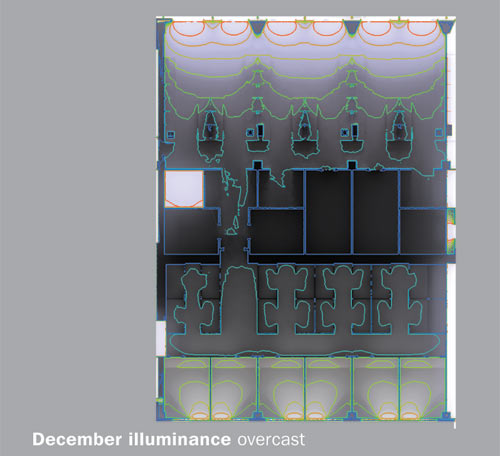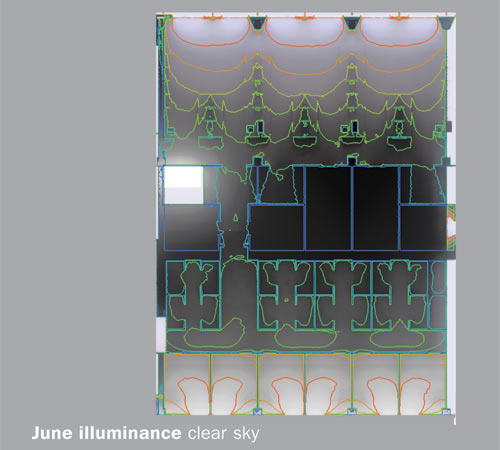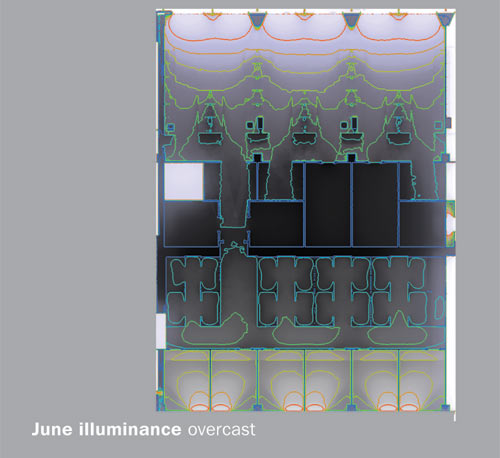This CE Center article is no longer eligible for receiving credits.
Despite a growing preoccupation among the general public with all things green and an industrywide awareness about the built environment's role in the depletion of natural resources, there is little available information about how buildings designed with sustainability in mind actually perform. Once the construction trailer is taken away, and the owner settles in, architects seldom systematically review a completed project to understand if it met its design objectives, if the occupants are comfortable and productive, or if it conserves energy and water.
One rarely used but potentially powerful tool for gathering such information is a postoccupancy evaluation, or POE. Though there is no standard definition of the process, a POE can consist of an analysis of resource consumption, an assessment of physical conditions such as lighting levels or acoustics, and an occupant survey or interview. A variety of other names are often used to refer to such a study, including environmental-design evaluation, building-in-use assessment, and facility-
performance evaluation, but POE is the most common term.
No matter what term is used, advocates of the practice say that widespread adoption of such studies, and sharing of the resulting information, would help advance sustainable design because the evaluation can help identify strategies that work best, those that need refinement, and those that should not be repeated on future projects. Although designers might worry about the liability associated with an unsuccessful aspect of a project exposed during a POE, sources are reassuring: "Architects get nervous being held accountable," says Craig Zimring, an environmental psychologist and a professor in the College of Architecture, at the Georgia Institute of Technology, Atlanta. "However, I don't know of a single instance where a POE resulted in a lawsuit, but I know of many instances where a POE helped avoid one," he says.
 |
At the Global Ecology Center, radiant slabs and air-to-air heat exchangers reduce the energy needed to condition ventilation in the largely daylit labs.
Photo © Peter Aaron/Esto |
|
In fact, the involvement with a project after its completion that is necessarily required for a POE can help enhance the rapport between architects and owners, sources point out. "The process strengthened our relationship with our clients," says Sandy Mendler, AIA, senior design principal in HOK's San Francisco office. The firm recently conducted POEs on several of its green buildings.
 |
The
spider graph shows the percentage of satisfied Global Ecology Center occupants.
Graph courtesy Center for the Built Environment |
|
One of the most important steps in the POE process is obtaining occupant feedback. Though their opinions about physical characteristics such as indoor air quality, privacy, and lighting are by nature subjective, they are nevertheless essential to understanding how well a building performs. "If we were only concerned about energy use, we could easily achieve 2030," says Max Richter, an intern architect in the Vancouver office of Stantec, referring to the 2030 Challenge, the goal for carbon-neutral buildings set out by Santa Fe, New Mexico architect Ed Mazria and adopted by several key industry organizations. However, occupants would likely be uncomfortable if lighting levels were lowered and thermostats adjusted, points out Richter, who is involved in a POE of one of the Stantec's projects.
Despite a growing preoccupation among the general public with all things green and an industrywide awareness about the built environment's role in the depletion of natural resources, there is little available information about how buildings designed with sustainability in mind actually perform. Once the construction trailer is taken away, and the owner settles in, architects seldom systematically review a completed project to understand if it met its design objectives, if the occupants are comfortable and productive, or if it conserves energy and water.
One rarely used but potentially powerful tool for gathering such information is a postoccupancy evaluation, or POE. Though there is no standard definition of the process, a POE can consist of an analysis of resource consumption, an assessment of physical conditions such as lighting levels or acoustics, and an occupant survey or interview. A variety of other names are often used to refer to such a study, including environmental-design evaluation, building-in-use assessment, and facility-
performance evaluation, but POE is the most common term.
No matter what term is used, advocates of the practice say that widespread adoption of such studies, and sharing of the resulting information, would help advance sustainable design because the evaluation can help identify strategies that work best, those that need refinement, and those that should not be repeated on future projects. Although designers might worry about the liability associated with an unsuccessful aspect of a project exposed during a POE, sources are reassuring: "Architects get nervous being held accountable," says Craig Zimring, an environmental psychologist and a professor in the College of Architecture, at the Georgia Institute of Technology, Atlanta. "However, I don't know of a single instance where a POE resulted in a lawsuit, but I know of many instances where a POE helped avoid one," he says.
 |
At the Global Ecology Center, radiant slabs and air-to-air heat exchangers reduce the energy needed to condition ventilation in the largely daylit labs.
Photo © Peter Aaron/Esto |
|
In fact, the involvement with a project after its completion that is necessarily required for a POE can help enhance the rapport between architects and owners, sources point out. "The process strengthened our relationship with our clients," says Sandy Mendler, AIA, senior design principal in HOK's San Francisco office. The firm recently conducted POEs on several of its green buildings.
 |
The
spider graph shows the percentage of satisfied Global Ecology Center occupants.
Graph courtesy Center for the Built Environment |
|
One of the most important steps in the POE process is obtaining occupant feedback. Though their opinions about physical characteristics such as indoor air quality, privacy, and lighting are by nature subjective, they are nevertheless essential to understanding how well a building performs. "If we were only concerned about energy use, we could easily achieve 2030," says Max Richter, an intern architect in the Vancouver office of Stantec, referring to the 2030 Challenge, the goal for carbon-neutral buildings set out by Santa Fe, New Mexico architect Ed Mazria and adopted by several key industry organizations. However, occupants would likely be uncomfortable if lighting levels were lowered and thermostats adjusted, points out Richter, who is involved in a POE of one of the Stantec's projects.

 |
The mean satisfaction score for the 39 LEED buildings in the CBE database was consistently better than that for the 284 noncertified buildings.
Graphs courtesy Center for the Built Environment |
A systematic and reliable way to gather information about occupant comfort is through a Web-based survey such as the one administered by the Center for the Built Environment (CBE) at the University of California, Berkeley. CBE's Occupant Indoor Environmental Quality Survey costs about $1,000 per building to implement. After initial setup by the owner or design team, it typically takes participants about 10 minutes to complete, and includes questions about key aspects of the indoor environment, such as office layout, thermal comfort, air quality, acoustics, and lighting.
The center conducted its first survey in 2000, and to date has collected responses from 45,000 individual occupants in more than 300 buildings. The database includes 4,500 responses from occupants of 39 LEED-certified buildings, providing an opportunity to better understand the successes and shortcomings of green design strategies. Users can benchmark their buildings against others in the database on factors such as type, size, or geographic location. "We can slice the data in any number of ways," says John Goins, a CBE research specialist. "For example, we could compare LEED Gold buildings with operable windows in California," he says.
 |
 |
 |
A downdraft cooling tower keeps the lobby (middle) of the Global Ecology Center comfortable. Night sky radiation (top) cools water that chills the building's slabs. An open office plan
(above) facilitates daylighting and natural ventilation. But some occupants complained about acoustics.
Photo © Peter Aaron/Esto |
|
One building that performed particularly well in the CBE survey is the Global Ecology Center of the Carnegie Institution for Science, which opened on the campus of Stanford University in California four years ago. The largely daylit, 11,000-square-foot, two-story lab-and-office building, designed by EHDD Architecture, San Francisco, is cooled almost entirely by natural systems. It relies on a downdraft cooling tower to provide evaporative cooling to the lobby, and a radiant slab system coupled with operable windows to keep workspaces comfortable. The water that chills the slabs is cooled by an unusual night-sky radiation system.
The center ranked above the 90th percentile of all buildings in the CBE database in almost all of the survey's categories. The two exceptions were acoustics and lighting, though the building still scored above the mean in both categories. Scott Shell, AIA, EHDD principal, says that users have ample light to perform their tasks at their workspaces. However, the space as a whole seems dark because occupants turn off wall washers in order to reduce the building's carbon emissions, he says. "We try to light the wall and ceiling surfaces, not just the work surface. This often provides a more interesting sculptural [effect], as well."
He associates the dissatisfaction with the building's acoustics with the second floor's open office layout central to both the daylighting and natural ventilation strategies. And he points to the nature of the occupants' work, which requires that they have the ability to concentrate alone, and that they gather in teams, often generating noise. "Those activities fundamentally conflict," points out Shell. In response, the firm has been working closely with its consultants, paying close attention to the use of thermal mass and how much of it is exposed, and looking for ways to combine acoustical isolation of spaces with natural ventilation strategies.
 |
 |
 |
As a result of its POE findings, HOK is performing more comprehensive analysis of its buildings during the design phase. Some of the studies
for a planned veterinary lab at the University of California, Davis (top) include an examination of the effect of window openings and glazing types on lab space daylighting (middle and above).
Images courtesy HOK |
|
The CBE survey was also part of HOK's recent evaluation of 10 buildings that it felt were among its most successful green projects. In addition to the occupant survey, the assessment process included a third-party energy evaluation based on utility bills and maintenance records, and an end-user interview conducted by HOK staff and intended to collect more detailed information about specific sustainable solutions. The process cost about $5,000 per building, an expense the firm paid for itself in order to better understand if design goals had been realized. "Clients would inevitably ask how these buildings were performing," says Mendler.
The sample of HOK's projects represented a variety of building types, including offices, laboratories, and academic buildings that had been occupied between one and five years. The examination of these projects revealed that owners and users were generally very satisfied with the HOK projects. However, a few areas of improvement were identified. For example, though occupants were pleased with the access to daylight that most of the projects provided, some reported problems with spill light and glare. And as with the EHDD project, the occupants of open office environments in HOK's buildings also reported dissatisfaction with acoustics and the level of privacy.
On some projects, the study also showed a disconnect between energy savings predicted through energy modeling and those actually realized. Notably, those HOK projects that scored highest in the CBE survey's thermal-comfort category were also the most efficient. "Thermal comfort wasn't sacrificed in order to achieve energy-use savings," says Mendler. The buildings that were found to be less efficient also tended to be those with the benefit of minimal or no commissioning, had no sustainable-design consultant as an integral part of the project team, or were subject to late design changes, she adds.
As a result of this examination, the firm is instituting a more integrated design process, placing more emphasis on commissioning with its clients, and investing more resources in analysis tools for daylighting and acoustics. One project that should benefit from these efforts is a 122,000-square-foot laboratory that the firm is designing for the school of veterinary medicine at the University of California, Davis, slated for occupancy in 2012. To refine the daylighting and sun-control strategy for the open lab and office suites, the HOK design team studied a physical model of the building using the Pacific Gas & Electric heliodon at the utility's Energy Center in San Francisco. It also used building information modeling (BIM) and simulation tools to compare glazing and facade options under a wide variety of environmental conditions in order to better understand foot-candle levels and avoid glare. "These types of analyses were not regularly part of our design process," says Mendler. "We would make design decisions based on average conditions and then have our engineers calculate the impact on energy use," says Mendler.
 |
 |
 |
 |
As part of its effort to improve the daylighting in its buildings, HOK is more thoroughly examining the relationship between facade options and environmental conditions. Some of those investigations-a selection of illuminance studies for a lab building planned for the University of California, Davis-are shown here.
Images courtesy HOK |
|
Although interest in POEs is growing as both owners and designers become increasingly interested in verifying performance claims, there is still no industrywide accepted method for conducting such an evaluation. But a handful of North American efforts do exist. For example, the White Salmon, Washington−based nonprofit organization the New Buildings Institute (NBI) has developed what it calls a "market friendly" POE protocol intended to provide a basic set of performance indicators. The protocol includes an energy-bill assessment, a facility-manager interview, and an occupant survey that requires minimal up-front documentation by the owner. "Our intent is for the process to take as little time as possible," says Cathy Turner, NBI senior analyst. The organization recently completed a pilot test of the protocol with a large Seattle-area school district and is searching for partners to help finalize the program for more widespread use.
A more comprehensive protocol has been developed by engineering and architecture firm Stantec, in conjunction with the Canadian not-for-profit EcoSmart Foundation. Tested on six Vancouver buildings, the resulting Building Performance Evaluation (BPE) tool (available free of charge at www.ecosmart.ca) outlines a process that integrates the CBE survey, a building-operator interview, energy and water consumption analysis, and physical measurements of environmental conditions, including indoor air quality, lighting levels, and acoustics.
After finalizing the protocol last year, the BPE team now hopes to develop a cumulative index that would allow this comparison of buildings, says Rosamund Hyde, a Stantec senior research engineer and manager of the Ecosmart BPE project. The advantage of such a standardized evaluation process is that it would allow the benchmarking of one building against others using the same protocol, she points out.
Stantec will soon wrap up the evaluation of one of its own projects, a 40,000-square-foot learning center at the Vancouver Aquarium designed in collaboration with local architect Clive Grout and completed in late 2006. The building, known as Aquaquest, includes laboratory space for school children, a gallery, a theater, and administrative offices. The project deploys a number of sustainable strategies, such as thermal mass for heating and cooling, collection of rainwater to flush toilets, and a 500-square-foot vertical garden covering one of its exterior walls. It is targeting a Gold rating under the Canadian LEED system.
 |
Aquaquest designers are wrapping up a comprehensive POE of the building.
Photo © Colin Jewall |
|
The full BPE of Aquaquest, including the Web-based survey, the energy- and water-use analysis, and the physical diagnostics, will cost Stantec about C$25,000, according to Richter, who in addition to helping implement the project's evaluation, was also a member of the design team. But Stantec anticipates that the value of the information will be enormous. "This evaluation [process] provides feedback that most building owners and design teams can only guess at," says Richter. "Not doing postoccupancy building evaluation is like flying blind."























